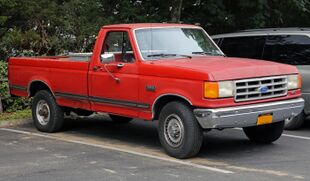Ford F-Series (eighth generation)
Topic: Engineering
 From HandWiki - Reading time: 6 min
From HandWiki - Reading time: 6 min
| Eighth generation | |
|---|---|
 1989 Ford F-250 Custom | |
| Overview | |
| Manufacturer | Ford |
| Also called | Ford F-1000 (Brazil and Argentina) Ford F-4000 (Brazil and Argentina) |
| Production | 1986–1991 (USA, Mexico, Canada, and Venezuela)[1] 1987–1992 (Australia)[2] 1988–1992 (Argentina) 1992–1995 (Brazil) 1993–1995 (Argentina, Brazilian trim model) |
| Assembly | Cuautitlán, Mexico Kansas City, Missouri, USA Norfolk, Virginia, USA St. Paul, Minnesota, USA General Pacheco, Argentina São Bernardo do Campo, Brazil Louisville, Kentucky, USA Wayne, Michigan, USA Oakville, Ontario, Canada Melbourne, Australia (Broadmeadows Assembly Plant, Ford Australia) [2] |
| Body and chassis | |
| Body style | 2-door pickup 2-door extended cab pickup 4-door chassis cab 2-door chassis cab |
| Powertrain | |
| Engine |
|
| Transmission | |
| Chronology | |
| Predecessor | Ford F-Series seventh generation (1980–1986) |
| Successor | Ford F-Series ninth generation (1992–1996) |
The eighth generation of the Ford F-Series is a line of pickup trucks and light- to medium-duty commercial trucks produced by Ford from 1987 to 1991. While the 1980 cab and chassis was carried over to the new model, the 1987 model was more streamlined, and maintenance items were made simpler. The exterior was facelifted with new composite headlamps, a more aerodynamic front end, and circular fenders. Inside, the interior was given a complete redesign. Rear antilock brakes were now standard, the first pickup truck to boast this. For the first time, all models were produced with straight-sided Styleside beds; the Flareside bed was discontinued except for a small number of early 1987 models using leftover 1986 beds with new circular fenders. In October 1989, Ford premiered the ninth-generation taillights (the white reverse light was decreased in size) on the last year of the eighth generation.
Trims
- Custom – Included: Vinyl upholstery, black steering wheel, chrome front bumper, black grille, hubcaps, foldaway mirrors, and an electronic AM radio with digital clock and two speakers.
- XL – Added: Cloth and vinyl upholstery, swingaway mirrors, front bumper rub strip, color-keyed floor mat, a door trim panel with map pocket, and a color-keyed headliner.
- XLT Lariat – Added: Cloth upholstery, chrome grille, sport wheel covers, tinted glass, carpeting, and leather-wrapped steering wheel.
- Nite (1991) – Included: All blacked-out exterior trim, either a pink or blue/purple stripe, and a "Nite" decal on the sides of the cargo box. Was only available in black and on F-150 models equipped with a V8 engine.
Models

Eighth-generation Ford F-Series models are:
- F-150: 1/2 ton (6,250 lb GVWR max)
- F-250: light-duty 3/4 ton (7,700 lb GVWR max)
- F-250HD: 3/4 ton (8,800 lb GVWR max)
- F-350: 1 ton Class 2 or Class 3 truck (11,000 lb GVWR max)
- F-Super Duty: Class 4 truck (14,500 lb GVWR max)[3]
The new-for-1988 F-Super Duty was essentially a Class 4 truck built as a chassis cab, with an aftermarket bed (specific to its future use) added after the truck was built. The F-Super Duty came with dual fuel tanks with a dash-mounted toggle switch to switch between each tank, while using only a single fuel gauge. It came with a PTO used to power attachments, such as winches or a dump bed, directly from the transmission. F-Super Duty models two-wheel-drive only, were rated at about 14,500 lb (6,577 kg) GVWR, and came with either the standard 7.5 L (460 CID) gasoline V8 or the optional 7.3 L (444 CID) diesel V8. Other mechanical upgrades from the dual-rear-wheel F-350 included four-wheel disc brakes, 10-lug wheels, and a monobeam leaf-sprung front axle. The transmission was a five-speed manual or a three-speed automatic, with the four-speed electronically-controlled E4OD also offered beginning in 1990.[3] There was also a stripped chassis available, offering a 16,000 lb (7,257 kg) GVWR on two wheelbases of 158 or 178 in (4,013 or 4,521 mm) and the 7.3 L diesel engine as the sole option.[3] This model should not be confused with the later Super Duty commercial line of trucks starting with the 1999 model year.
Brazil
It was built from 1992 to 1995. The 1992 model carried over the MWM D229-4 and MWM TD229-4 engines from the previous generation. 1993 brought no notable changes. 1994 introduced a 4×4 model and a 2-door extended cab model marketed as "SuperCab." 1995 introduced the Ford 300 4.9-liter inline-six engine.
Powertrain and chassis
In a move to further update the F-Series engine lineup, the 4.9 L inline-6 was converted to fuel injection for 1987. A year later, Ford became the first pickup truck manufacturer to sell a fully non-carbureted engine lineup as the 5.8 L V8 and 7.5 L V8 also gained multiport fuel injection (the 5.0 L V8 had gained fuel injection as an option for 1985 and this was made standard in 1986). For 1988, the diesel V8 from International (Navistar) was enlarged to from 420 to 444 cubic inches (6.9 to 7.3 L); this allowed for an increase to 180 hp (130 kW) and 365 ft⋅lbf (495 N⋅m) of torque.
While the dated 3-speed column-mounted manual transmission was discontinued, much of the rest of the transmission lineup carried over from the 1980–1986 trucks. In 1988, the five-speed ZF S5-42 replaced the Borg-Warner T19 in F-250 and F-350 models. For the F-150 and light-duty F-250, the heavier-duty Borg-Warner T18 4-speed manual remained available, while the Mazda-built M5OD 5-speed manual was added to the model lineup for models equipped with the 4.9 L inline-6 and 5.0 L V8.
Four-wheel-drive improvements included the addition of automatic locking hubs for the F-150 in 1989. Models with the 5.0L V8 also had an option of a "Touch Drive" electronic transfer case.[citation needed]
From 1980 through 1996, Ford offered a four-wheel-drive swing arm independent front suspension called Twin-Traction Beam (TTB). Based on its two-wheel-drive Twin-I-Beam suspension from 1965, Ford mounted a Dana 44 or Dana 50 differential in the driver-side front axle beam and transmitted torque to the passenger-side wheel with a U-jointed axleshaft. TTB coil springs were still used on the F-150, while the four-wheel-drive F-250 and F-350 got leaf springs. The F-250 received TTB Dana 50 axles, and the F-350 a solid Dana 60 axle.
Engines:
| Name | Production | Engine type/Displacement | Power | Torque | Fuel Delivery |
|---|---|---|---|---|---|
| 300 Six | 1987–1991 | 300.1 cu in (4,918 cc) I6 | 145 hp (108 kW) | 265 lb⋅ft (359 N⋅m) | EFI |
| 5.0 Windsor | 1987–1991 | 301.6 cu in (4,942 cc) V8 | 185 hp (138 kW) | 270 lb⋅ft (366 N⋅m) | EFI |
| 5.8 Windsor | 1987 | 351.9 cu in (5,766 cc) V8 | 210 hp (157 kW) | 305 lb⋅ft (414 N⋅m) | 4-bbl carburetor |
| 1988–1991 | 210 hp (157 kW) | 315 lb⋅ft (427 N⋅m) | EFI | ||
| 460 V8 | 1987 | 460 cu in (7,538 cc) V8 | 225 hp (168 kW) | 362 lb⋅ft (491 N⋅m) | 4-bbl carburetor |
| 460 V8 | 1988–1991 | 460 cu in (7,538 cc) V8 | 225 hp (168 kW) | 390 lb⋅ft (529 N⋅m) | EFI |
| International 6.9L IDI V8 | 1987 | 420 cu in (6,883 cc) Diesel V8 | 170 hp (127 kW) | 315 lb⋅ft (427 N⋅m) | Indirect fuel injection |
| International 7.3L IDI V8 | 1988–1991 | 444 cu in (7,276 cc) Diesel V8 | 180 hp (134 kW) | 345 lb⋅ft (468 N⋅m) | Indirect fuel injection |
References
- ↑ Parker, Steve (August 1986). "Pickup Trucks Buyers' Guide". Popular Mechanics (Hearst Magazines): 97. https://books.google.com/books?id=0OMDAAAAMBAJ&pg=PA97.
- ↑ 2.0 2.1 Kenwright, Joe (2006-09-29). "Used Car Advice: Ford F-series (1985-92)". Motoring. carsales.com Limited. Archived from the original on 2020-08-30. https://web.archive.org/web/20200830194124/https://www.motoring.com.au/used-car-advice-ford-f-series-1985-92-1945/.
- ↑ 3.0 3.1 3.2 Mele, Jim (July 1990). "The New Models for 1991: Mid-Range Trucks". Fleet Owner (FM Business Publications) 85 (7): 70.
 |
 KSF
KSF
